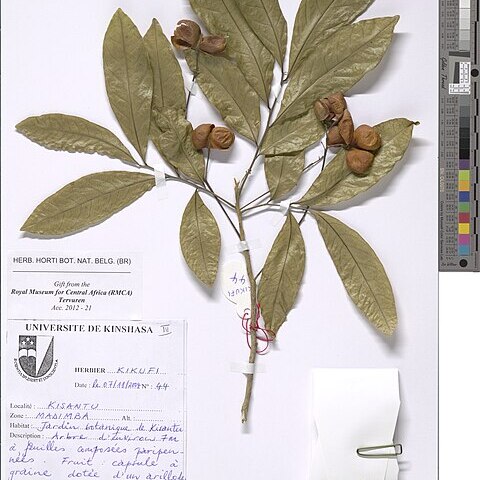(Shrub to) tree; up to 20(-40) m high, dbh up to 40(-100) cm; (buttresses up to 2 m high and 2 m spreading). Twigs 2-10 mm thick; usually glabrous but for the terminal bud (to all young parts up to and including the infructescences densely appressedly short-hairy and usually early glabrescent). Leaves (l-)3-6(-7)-jugate; petiole up to 20 cm long; petiolules 2-12 mm long; axes glabrous (or sparsely puberulous). Leaflets ovate (lower ones) to elliptic to obovate (upper ones), 5-36 by 2-15 cm, index 1.5-4, herbaceous to chartaceous; base symmetrical to oblique, acute or the broader apical half (rarely both halves) rounded, (not or) only slightly decurrent; apex acute to rounded to gradually to abruptly acuminate, acumen short to rather long, rounded or retuse (to acute); glabrous or very sparsely hairy on midrib and below on nerves; midrib above usually slightly raised to ba-sally sunken, (or raised or sunken over its whole length); nerves 0.75-3 cm apart, above slightly sunken; intersecondary nerves feeble (or absent). Inflorescences axillary (to pseudoterminal to truly terminal), erect or pendulous, infructescences more often ± pendulous, solitary, 5-85 cm long, simple (or with a strong branch near the base), usually sparsely and ± widely branched, often ± few-flowered, the upper parts usually tardily hairy, for the rest glabrescent; pedicels in fruit 3-7.5 mm long; bracts small, simple (or ternate) leaves. Flowers fragrant. Sepals elliptic to suborbicular, 3-6 by 2.5-4.5 mm, persistent in fruit. Petals oblong-obovate to oblanceolate, 5-10 by 2-3 mm, white to creamy (yellow, greenish, pink), glabrous. Disc complete, low, short-velvety. Stamens 5 (or 6); filaments 2.5-3.5 mm long, white; anthers 1.5-3.5 mm long, yellowish white, greyish yellow, or dark mauve. Pistil 2-locular; ovary light green, yellow, or reddish brown; style 1.75-6.5 mm long, light green, stigma whitish; ovules 1 per locule (to 2 in one of the locules). Fruits slightly kidney-shaped, transversely ellipsoid, broadly ovoid, obovoid, or globular, 12-20 by 12-32.5 mm; base rounded to truncate (to slightly concave), stipe 1-3 mm long; apex slightly concave to obtuse-angular, apiculate; wall leathery to woody, outside and inside red, outside variably hairy, early to late glabrescent, inside glabrous to very laxly rather long hairy or glandular hairy. Seeds shining brown to black with a bright glossy red arillode.
More
Trees, to 20 m tall. Bark black or dark gray; branches strong, stout, only young parts golden tomentose. Leaves with petiole 15-50 cm, axis grooved, subglabrous; leaflets 3-6-jugate, sometimes 7-jugate; petiolules 5-8 mm; blades adaxially shiny, obliquely lanceolate, asymmetrical, 6-12 × 2-4 cm, thinly leathery, glabrous; lateral veins ca. 10 pairs, slender, base cuneate, apex acuminate or shortly acuminate. Inflorescences sparse, axillary or terminal, shorter than leaves, slender; bracts lanceolate, deciduous. Flowers fragrant. Pedicels 6-8 mm. Se-pals broadly ovate, ca. 5 mm or slightly longer, tomentose, persistent. Petals 8-10 mm, slightly fleshy, cuneate. Disk tomentose. Stamens 5, slightly shorter than petals. Ovary ovoid, tomentose. Capsules brown, subglobose or transversely ellipsoid, compressed, ca. 2 × 2-3 cm, glabrous when mature. Seeds black-brown, ovoid or ellipsoid, 1.3-1.5 cm, arillode covering all of seed. Fl. spring-summer, fr. late autumn.
Primary and secondary rain forest, sometimes in light forest, teak forest, tidal forest, scrub, or open places; on slopes and ridges, river banks, ravines, flats and beaches; usually on dry (to swampy) soil; sea level to 1,200 m, occ to 1,800 m.


